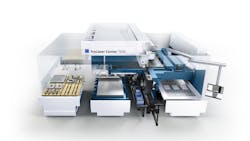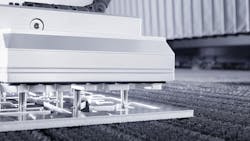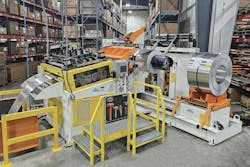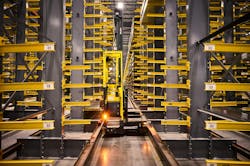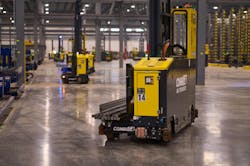What Are They Using? A Peek Into Manufacturers' Equipment Choices
Have you ever been curious what your main competitor or even just other companies similar to you are using in their facilities? Maybe you saw a machine or piece of equipment and want to know where it was from and if they like it?
In this recurring news round-up, we'll be compiling all the news about who bought what, who delivered what to who, and so on so you can see how other companies are operating and the tools they're using.
Miller Fabrication Solutions Expands Production Capabilities and Automation With Trumpf
Miller Fabrication Solutions recently acquired a Trumpf TruLaser Center 7030 to be able to produce complex and intricate parts for Original Equipment Manufacturers (OEMs).
As a strategic steel fabrication partner, the full-service laser cutter optimizes Miller's production, automatically handling every process from drawing to sorted part. The machine has increased capacity and enabled Miller to work autonomously 24/7. Since the company also combined multiple laser-cutting processes in the TruLaser Center 7030, it was also able to reduce throughput times and parts costs.
Installed at Miller's new Pine Creek plant in Pennsylvania, its fourth facility which the company is using to further its automation vision, the Trumpf laser removes and sorts cut parts from nests. Miller's investment in the machine is the first step in the company’s plan to remove the vast majority of denesting from the plant floor by the end of 2024.
"Miller Fabrication Solutions' goal is to remove as much manual denesting from the shop floor as possible. Equipment limitations will prevent automated removal of some very heavy or very small parts, but with the addition of the Trumpf laser and a plasma cutter that will be installed before year-end—both of which have denesting capabilities—we'll be able to achieve upwards of 90% automated denesting," said Eric D. Miller, President, Miller Fabrication Solutions.
Eric D. Miller went on to explain that there are several reasons why the company has made removing manual denesting a forefront goal: "First, performing manual denesting is a non-value-added activity—that is, it doesn’t add to the finished part—and we want to eliminate as much of that work as possible. Second, it’s physically difficult work. Although we provide employees with training and personal protective equipment (PPE) and take every safety precaution, manual denesting still poses a risk to our workers. The more we can automate the denesting process, the more we also eliminate any risk of a safety incident. Third, as cutting technologies advance and Miller is able to handle more materials and cut faster, manual removal becomes a choke point. Automating allows denesting to be completed as fast as our machines can cut, creating significant efficiencies and enabling us to increase the amount of parts we can produce for customers. Finally, automated denesting helps Miller fight back against the skilled labor shortage, which is well-recognized in the manufacturing industry. We view automated denesting as a method of continuous improvement that allows us to retrain our team members—through our weld school and other internal programs—to work in more value-added positions like machine operation, painting, and welding."
With the TruLaser Center 7030, dynamic pins under the cut blanks push them up to mate with grippers, which stack parts on pallets. Integrated automation ensures parts are reliably handled, eliminating the need for post-processing and allowing the highest quality. The machine achieves peak values in cutting dynamics with up to 12 kW of laser power.
At Pine Creek, the TruLaser Center 7030 is connected to a storage array, where finished parts are stored. Future machinery can be connected to the storage array to gain access to the sorted parts and further automate downstream operations.
Manitowoc Tool and Manufacturing Chooses Another Dallas Industries Feed Line
Manitowoc Tool & Manufacturing, located in Manitowoc, Wisconsin, has chosen to install another conventional feed line from Dallas Industries, making it the third within the last two years. The production metal stamping, metal fabrication, and tool & die manufacturer provides turnkey solutions from initial design through assembly.
The line is a fully automated 60-in. wide conventional line featuring model DRFH-860, a centering reel, an alligator peeler/threader, a coil restrictor, model DPS-4-7-60 powered straightener, and a 30,000-lb. load capacity reel with load car.
To enhance setup, the unit incorporates the feeder passline height, edge guides, coil guide rolls for auto coil centering of the coil on the uncoiler, all of which are automatically adjusted to position. The settings for these axes are stored in the job recipe—a Dallas feature termed AutoSet.
The line is built on an Allen-Bradley, ethernet-based control architecture and features SyncLoop and ProfileSelect. The SyncLoop control synchronizes the feeder and straightener speeds to dramatically enhance the loop's stability and control.
ProfileSelect is a unique feed control system that is exclusively available through Dallas Industries. It uses a cam-motion (sinusoidal) profile. This smooth profile results in a feed motion that uses 100% of the press feed window, reducing stress on the material and the feed's mechanical components.
Dallas Industries' full line of products includes conventional and compact coil feed lines, as well as servo feeds, air feeds, heavy-duty straighteners, and coil handling equipment.
Central Steel & Wire Boosts Warehouse Efficiency With Combilift AGVs and Cantilever Racking From Steel King
When Central Steel & Wire (CS&W), a metal products and services supplier for a wide range of customers from job shops to large OEMs, decided to move from the Chicago facility that had been its home for 80 years, it wanted to create a state-of-the-art product depot and service center, using the most efficient material handling technology. To do so, CS&W chose to outfit its new facility with Automated Guided Vehicles (AGVs) and cantilever racking, moving from a labor-intensive manual operation to an efficient automated one.
“For the first time in the metal service center business, we brought in AGVs to replace standard material handling equipment. It allowed us to use driverless vehicles to store and pull materials to fulfill customer orders,” said Nicole Giesie, vice president of operations at Central Steel & Wire - a member of the Ryerson Family of Companies.
To get the full benefit of AGVs, the company needed to make sure the new facility had racking with consistent pocket locations that were evenly distributed and available throughout. The presence of damaged racking arms in the existing facility would also have reduced the effectiveness of the AGVs, Giesie noted.
“With AGVs, we were able to utilize our workforce in other value-added tasks rather than just moving metal throughout the facility,” Giesie said.
The new 900,000-square-foot facility in southern Chicagoland's Village of University Park needed 18,000 storage locations to accommodate 6,000 product SKUs with a combined weight of 50 million pounds of carbon steel, stainless steel, aluminum, and specialty metals. Space was also needed for value-added work, such as precision cutting and tube laser operations.
CS&W selected Steel King Industries, a manufacturer of storage rack and material handling products. The two companies have a long-standing relationship as CS&W supplies steel for Steel King's products.
“Based on our existing strong relationship with Steel King, its reputation for reliability and for manufacturing extremely durable racking, and its engineering expertise, we found them to have the best solution for our needs,” Giesie said.
“The racking system was able to have narrower aisles—and thus have a greater storage density—through an engineering solution designed by Steel King. Our engineers designed notches in rails to guide Combilift AGV vehicles, which meant that more space could be dedicated to racking rather than to aisles,” said Kurt Larson, the company's regional sales manager for the central U.S.
“The new racking system is allowing CS&W to operate more efficiently and with greater productivity. It also will let the company adjust racking to meet changing needs. In their former facility, the racking elements were all welded, so adjustments could not be made. With our system, they'll be able to reconfigure the racking to accommodate changing storage needs,” Larson said.
About the Author
Laura Davis
Editor-in-Chief, New Equipment Digest
Laura Davis is the editor in chief of New Equipment Digest (NED), a brand part of the Manufacturing Group at EndeavorB2B. NED covers all products, equipment, solutions, and technology related to the broad scope of manufacturing, from mops and buckets to robots and automation. Laura has been a manufacturing product writer for eight years, knowledgeable about the ins and outs of the industry, along with what readers are looking for when wanting to learn about the latest products on the market.

